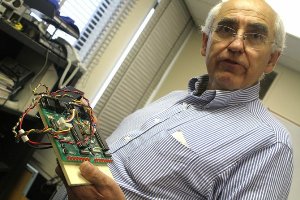Oct 6 2010
Roman Kuc Electrical Engineering Professor, Becton Center and Associate Dean of Educational Affairs at the Yale School of Engineering and Applied Science, has crafted a sensor named Robat, that apes bat-like sounds to be used in wheelchairs to move between objects and obstacles locating empty places, just like how bats navigate their way through dark caves to find food for themselves using sonar waves.
With a rich experience of almost 25 years in the field of robotics, he has built sensor models, and fixed them on to robots, and finally simulated them, utilizing mathematical software.
 Robat sensor
Robat sensor
While working on the Robat, Kuc observed that the ears of the bats are not straight, but point towards the sides, and he has used this observation by including angled sensors termed as vergence sensors, which are superior acoustically than the sensors that point straight in front. According to Kuc, these sensors were able to sense even very tiny movements.
Kuc has labored with dolphin robot replicas and Ultrasound normally used in medical imaging. James Duncan, a biomedical engineering professor and colleague, reveals that ultrasound signals frequently include plenty of interfering noises, making interpretations and piecing out relevant information difficult. While crafting his dolphin robot, the Rodolph, Kuc evaluates the data representing sonar energy, making use of 16 signals. He has plans of spreading out this research to include human ears, which are remarkably similar to bats by the presence of ridges. Human beings primarily use sight as their sensory base, but for blind people interpreting sounds by tapping their canes on floors or walls is of great benefit. They can even predict the distance of the wall, by analyzing the length of the sound echoing, when tapping the canes. Kuc’s upcoming research plans include, incorporating ridges in to sensors, to imitate bat and human ears.
According to Lawrence Steib, Professor Kuc’s colleague and fellow electrical engineering professor, the next challenge would be to create sensors for real-time applications, by converting the solutions in to real hardware and software systems.